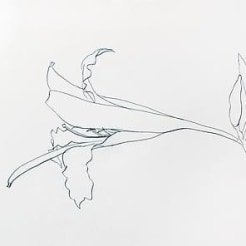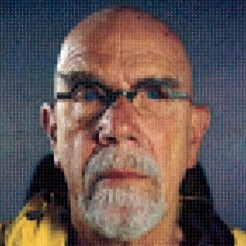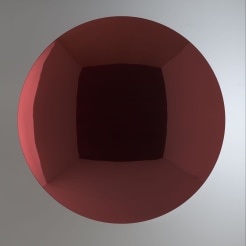Chuck Close began his career in 1968 with a black-and-white self-portrait painted from a photograph. This was the first note of the signature style which permeates his work. Since then Close has used a variety of media to create stark, hyperrealist portraits. They are closely cropped to eliminate body language and background, inviting the viewer’s attention. Close creates portraits by a process of transposing marks with a grid for reference. He explores a multitude of approaches to depicting his subjects, challenging himself by using materials and techniques that do not easily produce such realistic effects. Among the media Close has investigated are etching, aquatint, lithography, ink and fingerprints, traditional Japanese woodcut and reduction linocut. In 1988, Close had a spinal artery collapse which left him a quadriplegic. After time he regained some movement in his arms and legs and continues to paint with a brush held between his teeth or strapped to his hand. Although the paralysis restricted his ability to paint as meticulously as before, his style has changed very little. Close proved able to create his desired effects even in the most challenging circumstances. Close’s work can be found in over 65 major public collections worldwide, including the Albright-Knox Art Gallery, Buffalo; Art Gallery of Ontario, Toronto; The Art Institute of Chicago; Australian National Gallery, Canberra; Carnegie Institute, Museum of Art, Pittsburgh; The Cleveland Museum of Art; Des Moines Art Center; High Museum of Art, Atlanta; Hirshhorn Museum and Sculpture Garden, Washington DC; International Museum of Photography, George Eastman House, Rochester; Library of Congress, Washington, DC; The Metropolitan Museum of Art, New York; Musée national d’art moderne, Centre Georges Pompidou, Paris; Museum moderner Kunst, Palais Liechtenstein, Vienna; The Museum of Modern Art, New York; National Portrait Gallery, Washington DC; Osaka City Museum; Philadelphia Museum of Art; Seattle Art Museum; Staatliche Museum, Berlin; Virginia Museum of Fine Arts, Richmond; Walker Art Center, Minneapolis; Whitney Museum of American Art, New York; and Yale University Art Gallery, New Haven, among others.



